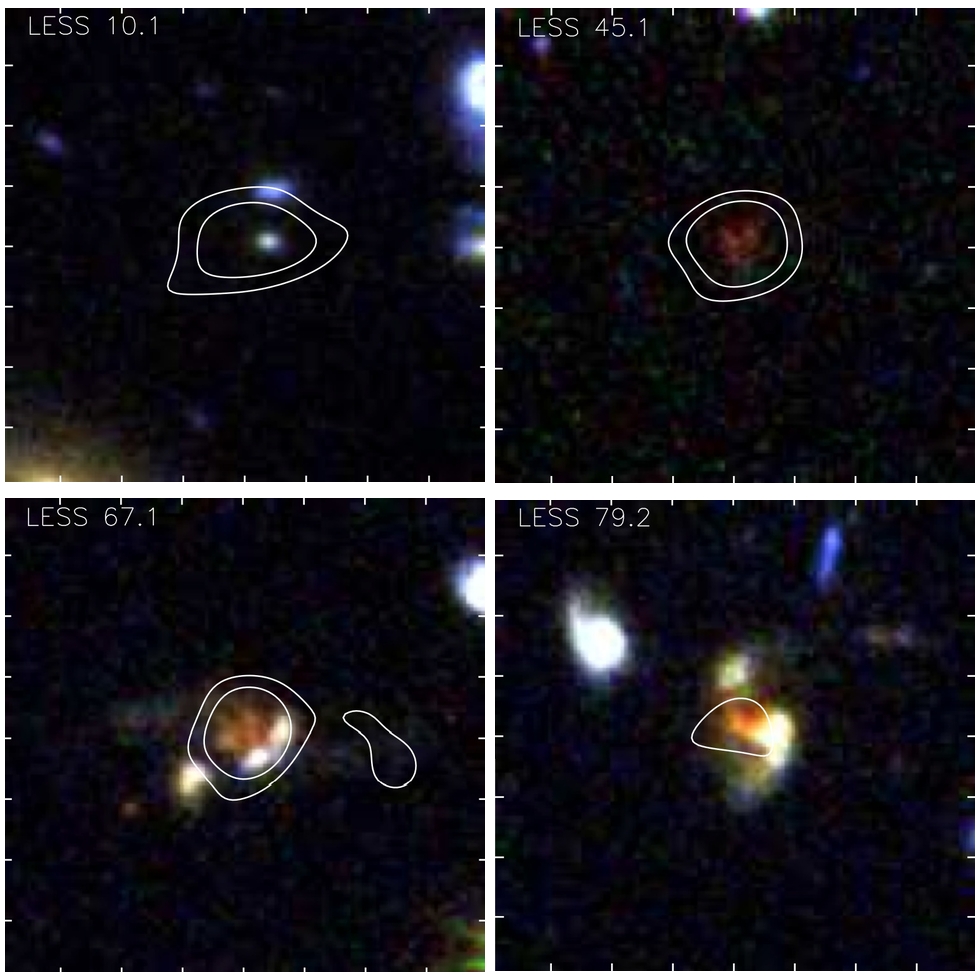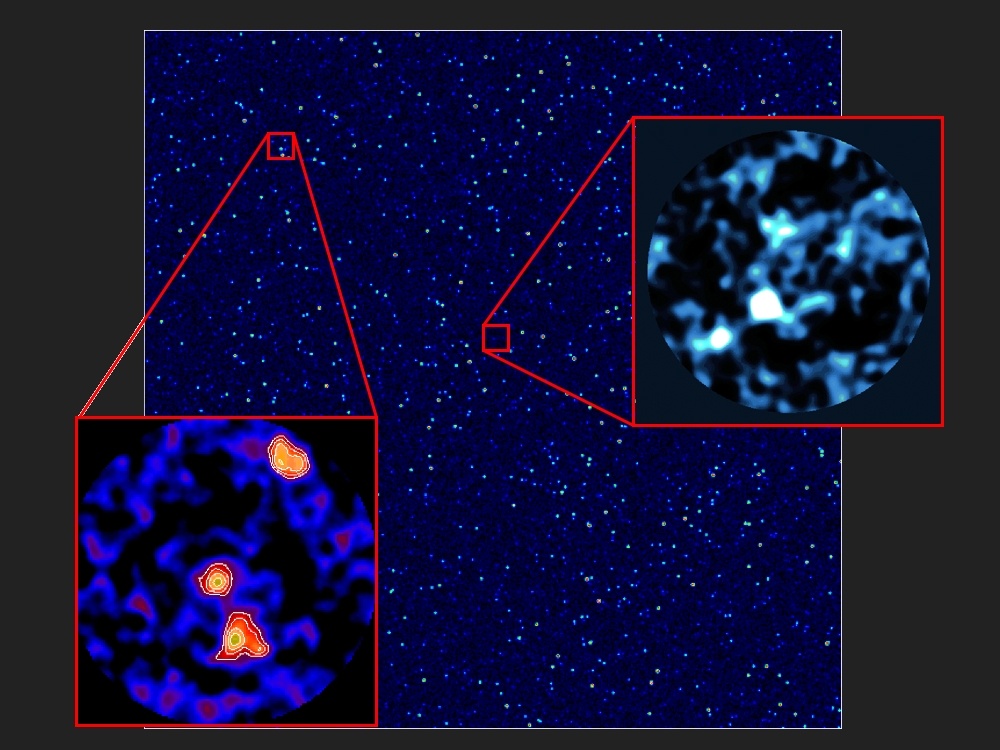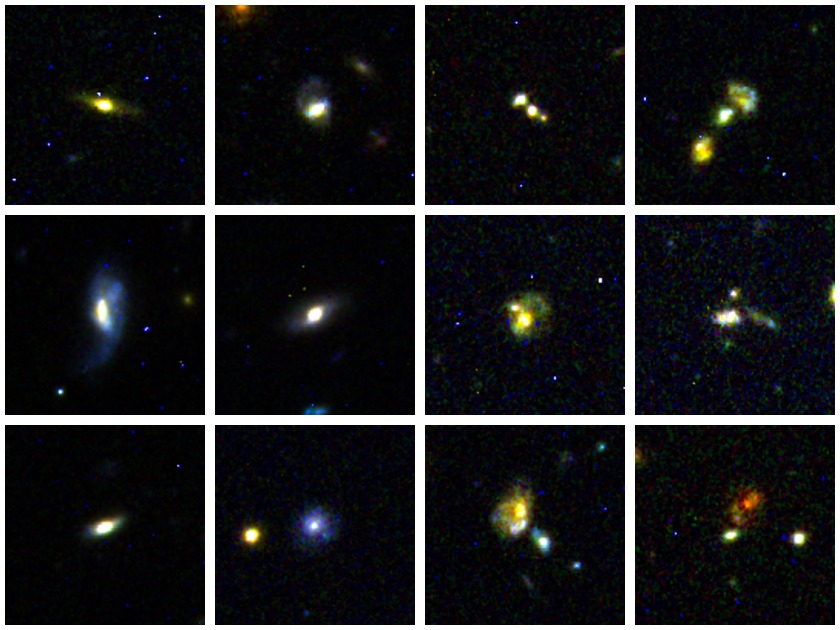CURRENT RESEARCH TOPICS
This page includes descriptions of some of the research programmes which I am currently undertaking. A description of some of my previous projects is given here. A few useful rules for operating in this field are given on this page.
Large ALMA surveys in the UDS and COSMOS fields
 The Atacama Large Millimeter Array (ALMA) is the most powerful sub/millimetre
interferometer on the planet. This instrument is capable of mapping the distribution
of dust and molecular and atomic gas within distant submillimetre galaxies in
exquisite detail. We have used ALMA to survey >1,000 submillimetre galaxies across three square degrees of sky in the well-studied UKIDSS Ultra Deep Survey and COSMOS fields. We have employed
these samples to investigate the properties and evolution of this population with samples which are an order of magnitude larger than anything previously available. More details of the results and the projects can be found here.
The Atacama Large Millimeter Array (ALMA) is the most powerful sub/millimetre
interferometer on the planet. This instrument is capable of mapping the distribution
of dust and molecular and atomic gas within distant submillimetre galaxies in
exquisite detail. We have used ALMA to survey >1,000 submillimetre galaxies across three square degrees of sky in the well-studied UKIDSS Ultra Deep Survey and COSMOS fields. We have employed
these samples to investigate the properties and evolution of this population with samples which are an order of magnitude larger than anything previously available. More details of the results and the projects can be found here.
ALESS: An ALMA/LABOCA Survey in ECDFS
 High-priority ALMA Cycle 0 and Cycle 1 time was awarded to ALESS a project to follow-up submillimetre galaxies
identified in the LESS submillimetre survey (see below).
The LESS submillimetre map had a spatial resolution of only 18 arcseconds FWHM, which is insufficient to precisely locate the submillimetre counterparts. In contrast, ALMA, even in its most compact configuration, has a resolution of 2 arcseconds, allowing us to precisely locate a large sample of the dust-obscured starbursts occuring in these systems for the first time. The image here shows HST optical images with the ALMA submillimetre emission overlaid as the contours. Thus ALMA provides unambiguous identifications for the submillimetre sources, many of which were previously unidentified. More information on the results from this programme can be
found here.
High-priority ALMA Cycle 0 and Cycle 1 time was awarded to ALESS a project to follow-up submillimetre galaxies
identified in the LESS submillimetre survey (see below).
The LESS submillimetre map had a spatial resolution of only 18 arcseconds FWHM, which is insufficient to precisely locate the submillimetre counterparts. In contrast, ALMA, even in its most compact configuration, has a resolution of 2 arcseconds, allowing us to precisely locate a large sample of the dust-obscured starbursts occuring in these systems for the first time. The image here shows HST optical images with the ALMA submillimetre emission overlaid as the contours. Thus ALMA provides unambiguous identifications for the submillimetre sources, many of which were previously unidentified. More information on the results from this programme can be
found here.
LESS was an extragalactic submm survey using the LABOCA Camera on the 12-m APEX Telescope. The project mapped the 0.5×0.5 degree Extended Chandra Deep Field South (ECDFS) field at 870um to a depth of ~1.2mJy. The LESS project was allocated 350 hours on LABOCA, with equal contributions from MPI and ESO. The PIs of LESS were: Ian Smail (ESO co-PI), Fabian Walter (ESO co-PI) and Axel Weiss (MPI PI). The survey was a collaboration of around 40 scientists based in Europe and the US and provided the foundation for the ALESS ALMA Cycle 0 survey.
SCUBA-2 Cosmology Legacy Survey
 The SCUBA-2 Cosmology Legacy Survey (S2CLS) was a collaboration of ~100
scientists in the UK, Canada and the Netherlands. The survey
exploited the immense increase in mapping speed, fidelity and sensitivity
of the new SCUBA2
submillimeter camera on the James Clerk Maxwell
Telescope in Hawaii. The goal of the survey was to provide the first
large samples of extragalactic sources selected in the 450- and 850-um
wavebands. These atmospheric windows allowed us to access the redshifted
far-infrared emission from luminous but highly, high-redshift galaxies
and AGN - pin-pointing an intense era of activity in the early Universe
associated with the formation of massive galaxies and black holes. The
survey has a simple two-tier design, comprising a wide 850-um component
and a deeper 450um survey over a smaller region. The 850-um
observations will deliver 1,000's of submillimetre galaxies, allowing
the first detailed statistical study of the submillimetre galaxy
population. At the same time the survey had the area coverage
needed to search for rare sub-classes of submillimetre galaxies
(e.g. transition objects) which provide powerful insights into the
processes operating within these systems, such as starburst- and
AGN-powered feedback, and trace overdensities of submillimetre sources
which potentially pin-point the initial collapse of proto-clusters. The very
deep 450-um observations enabled us to resolve for the first time
the bulk of the extragalactic background light at 450um, as well as
providing precise positions sufficient to directly identify the
counterparts to these sources in other wavebands. This single co-ordinated survey
programme will revolutionize our understanding of submillimetre
galaxies, and indeed galaxy formation in general, with enormous and
lasting legacy value, as well as providing a springboard for future
exploitation of Atacama Millimeter Array (ALMA), Herschel, LOFAR, James
Webb Space Telescope (JWST) and the Square Kilometer Array (SKA).
Further details and publications can be
found here.
The SCUBA-2 Cosmology Legacy Survey (S2CLS) was a collaboration of ~100
scientists in the UK, Canada and the Netherlands. The survey
exploited the immense increase in mapping speed, fidelity and sensitivity
of the new SCUBA2
submillimeter camera on the James Clerk Maxwell
Telescope in Hawaii. The goal of the survey was to provide the first
large samples of extragalactic sources selected in the 450- and 850-um
wavebands. These atmospheric windows allowed us to access the redshifted
far-infrared emission from luminous but highly, high-redshift galaxies
and AGN - pin-pointing an intense era of activity in the early Universe
associated with the formation of massive galaxies and black holes. The
survey has a simple two-tier design, comprising a wide 850-um component
and a deeper 450um survey over a smaller region. The 850-um
observations will deliver 1,000's of submillimetre galaxies, allowing
the first detailed statistical study of the submillimetre galaxy
population. At the same time the survey had the area coverage
needed to search for rare sub-classes of submillimetre galaxies
(e.g. transition objects) which provide powerful insights into the
processes operating within these systems, such as starburst- and
AGN-powered feedback, and trace overdensities of submillimetre sources
which potentially pin-point the initial collapse of proto-clusters. The very
deep 450-um observations enabled us to resolve for the first time
the bulk of the extragalactic background light at 450um, as well as
providing precise positions sufficient to directly identify the
counterparts to these sources in other wavebands. This single co-ordinated survey
programme will revolutionize our understanding of submillimetre
galaxies, and indeed galaxy formation in general, with enormous and
lasting legacy value, as well as providing a springboard for future
exploitation of Atacama Millimeter Array (ALMA), Herschel, LOFAR, James
Webb Space Telescope (JWST) and the Square Kilometer Array (SKA).
Further details and publications can be
found here.
HiZELS: The High-Z Emission Line Survey
 HiZELS was the first truly panoramic extragalactic narrow-band survey, roughly two-orders of magnitude larger than any similar previous study. The survey uses
the WFCAM instrument on the 3.8-m UK Infrared
Telescope utilizing a set of existing
and custom-made narrow-band filters in the J, H and K-bands to detect
emission line galaxies at z = 1-3.5 over ~10 square degrees of extragalactic sky in the UKIDSS DXS survey regions. The survey
employed the H2(S1) narrow-band filter to target H-alpha emitting galaxies
at z=2.23. In addition, in anticipation of this survey, we
purchased specially designed narrow-band filters targeting the [OII] emission line at
3727A and the [OIII] line at 5007A, in galaxies at the same redshift as the H-alpha
survey. Together these three sets of filters will enable
us to investigate the [OII] 3727, [OIII] 5007 and H-alpha emission from
galaxies at z=2.23, while the J- and H-band filters delivers
identically-selected H-alpha samples at z=0.84 and 1.47 respectively. The
comparisons between the luminosity function, the clustering and
variation with environment of these H-alpha-selected samples across z=0.8-2.2 yielded unique constraints on the evolution of star-forming
galaxies. The J-band filter is also sensitive to
Ly-alpha emission from galaxies at z=8.90 and provided constraints on theoretical predictions of their number density. This survey used 700 hours of time on UKIRT. Further details including all of
the papers can be
found here.
HiZELS was the first truly panoramic extragalactic narrow-band survey, roughly two-orders of magnitude larger than any similar previous study. The survey uses
the WFCAM instrument on the 3.8-m UK Infrared
Telescope utilizing a set of existing
and custom-made narrow-band filters in the J, H and K-bands to detect
emission line galaxies at z = 1-3.5 over ~10 square degrees of extragalactic sky in the UKIDSS DXS survey regions. The survey
employed the H2(S1) narrow-band filter to target H-alpha emitting galaxies
at z=2.23. In addition, in anticipation of this survey, we
purchased specially designed narrow-band filters targeting the [OII] emission line at
3727A and the [OIII] line at 5007A, in galaxies at the same redshift as the H-alpha
survey. Together these three sets of filters will enable
us to investigate the [OII] 3727, [OIII] 5007 and H-alpha emission from
galaxies at z=2.23, while the J- and H-band filters delivers
identically-selected H-alpha samples at z=0.84 and 1.47 respectively. The
comparisons between the luminosity function, the clustering and
variation with environment of these H-alpha-selected samples across z=0.8-2.2 yielded unique constraints on the evolution of star-forming
galaxies. The J-band filter is also sensitive to
Ly-alpha emission from galaxies at z=8.90 and provided constraints on theoretical predictions of their number density. This survey used 700 hours of time on UKIRT. Further details including all of
the papers can be
found here.